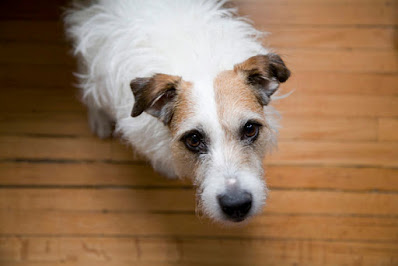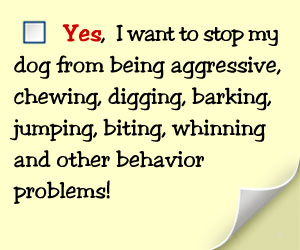How to deal with a whining dog
Whining in puppies
As puppies, it comes naturally: a very young puppy will whine without even realizing it when she’s hungry, tired, or cold. The mother dog will respond to this whining with milk, warmth, and a safe place to sleep – and as time goes on, the puppy begins to realize the association between the two. This is when she begins to whine deliberately, to notify her mom that something’s amiss or that she needs something.
When you adopt your pup, she should be between eight and ten weeks old. This is the time that a puppy will either learn that whining doesn’t work with her new, human family; or, she’ll learn to use whining as a manipulative tool (of sorts) to motivate her new “mommy” (that’s you!) to give her what she wants. This is why it’s generally advocated for you to leave your new puppy alone on her first night – if you respond to whining with positive attention (cooing, patting, sympathy, taking her out of the crate and cuddling her) how can she help but learn to whine until she gets what she wants?
You’ll need to use your common sense and good judgment, of course. For a really panic-stricken pup, she probably does actually need some attention and affection, if only to distract her from the scariness of her unfamiliar new surroundings. The trick is to respond in a timely manner so that she doesn’t feel like it’s her whining that’s got the result (or else you’re conditioning her to whine whenever she wants something, which is paving the road to hell).
For a puppy that’s working herself up into a real frenzy of crying and whining, don’t feel like you have to cold-bloodedly ignore her. By all means, pay her a bit of attention and calm her down – just initiate the contact when she’s no longer whining. It’s not always realistic to wait until she’s stopped whining altogether – contrary to popular (albeit misguided) opinion, some puppies simply do not stop whining and really will continue for hours on end. If you suspect that this may be the case, you don’t have to prolong your pup’s misery: just wait til she’s stopped for even a few seconds, then seize your moment and open the crate door. It’s not ideal, but under the circumstances, it’s likely the best you’ll be able to manage.
Whining in adult dogs
Whining is not a natural form of communication between humans and dogs. Most dogs grow out of whining around the six-month age; if your dog is whining after this period, it means she’s either doing it unconsciously, or she’s learned that it’s a useful motivatory tool to get her something that she wants or needs.
As an adult dog, there are a variety of reasons as to why she might be whining:
* In pain
* Bored/lonely
* Needs to go outside
* Afraid/anxious
Your response to her whining really depends on the cause of it. Sometimes whining is justified, and does require a response – and sometimes, it’s just plain manipulative. Other times it may be justified, but the response that comes most naturally won’t necessarily help your dog.
To clarify things, the more common reasons for whining – and suggested ways for you to react – are listed below.
When she’s whining out of pain
A dog that starts whining all of a sudden, and then keeps it up steadily afterwards, may be whining out of pain. This isn’t just limited to older dogs: puppies and young dogs can be subjected to some pretty severe growing pains, so don’t rule out this possibility on the basis of age.
If you think your dog may be in pain, check her over to see whether there’s any merit to this belief. First, check for the obvious signs: is she holding any paws off the ground, or favoring a limb/side of her body? Check her face and body for scratches and splinters. Next, you can palpate her limbs and joints for inflammation (like arthritis) and possible injuries. Remember to be very gentle: if she’s in pain, you don’t want to make it worse. Simply rub your hands along each leg, pausing at the joints to give each one a gentle squeeze. Run your hand down her tail to check for lumps and bumps, too. Even if you can’t find anything seriously amiss, if you think she’s whining out of pain, a trip to the vet is in short order.
When she’s whining out of boredom and/or loneliness
You’ll be able to tell if this is the cause because she’ll be wandering around the house (probably following you around, or pacing about the room you’re in), whining aimlessly and without direction (i.e. she’s whining to herself). The best cure for a dog that’s whining out of boredom is a quick shot of exercise: take her out for a brisk walk as soon as you can, and on a more general level, try to ramp up her daily exercise quotient. A tired dog is almost never a bored dog.
For a dog that’s whining from loneliness, you’ll have to try your best to spend more quality, interactive time with her. If you don’t have a lot of spare time to spend with your dog, then make the time that you do spend together really count: play, groom, train, cuddle.
When she’s whining out of fear/anxiety
Normally, it’ll be fairly easy to tell whether she’s whining out of fear or anxiety. When she’s afraid, it means there’s a direct cause to her fear – like a thunderstorm or a windy afternoon that’s rattling the windowpanes and spooking her a bit. If she’s anxious, it means there’s no direct, tangible cause for her edginess – she might be a bit on edge because you’re a bit stressed and she’s feeding off your energy, or perhaps there’s been a change to her daily routine (she didn’t get her normal morning walk, for instance).
Without spending any more time quibbling pedantically over semantics, your response to this sort of whining should always be one of discouragement. Don’t attempt to punish or correct her for whining out of fear or anxiety – that will simply increase her stress, making her feel worse and making the whining worse, too. Instead, simply ignore her. It’s a bit hard to do at first – in fact, it can feel like the least natural reaction in the world! But it really is the best thing for you to do.
If you lend unwonted credence to your dog’s mood with an excessive reaction – patting, sympathy, cooing – she won’t be comforted; she’ll actually be more worried, because you’ve just validated her fear. If it seems to her like you think she’s got a good reason to be worried/afraid – and if you react with comforting words and soothing pats, that’s how it’ll come across – then she’ll be more afraid. Not less. So in this case, you need to ignore the whining outright. Don’t molly-coddle her; instead, distract her with play, or run through a quick obedience routine.
Get her thinking about something else.
If she needs to go outside
If your dog’s whining because she needs to go outside, first of all you should give yourself – and her – a big pat on the back: it’s the sign of a genuinely well-trained dog. She needs to go badly enough to be whining about it, but she knows not to do it inside – and she’s smart enough to try and let you know that she needs to go out, too. This one’s easy: if she’s standing near the door, or just has That Expression (if you’ve had her for a while, you’ll grow to know That Expression – it’s different for every dog, but most owners are able to easily and correctly interpret it as meaning, “Let me out – now!”), you should let her out. It’s as easy as that.
Further Reading
For more information on dog ownership, including a huge variety of detailed information on canine problem behaviors, dog psychology, and the most effective ways to train your dog, take a look at Secrets to Dog Training. It’s the ultimate resource for the intelligent dog owner, and it covers just about every subject pertaining to the care of your beloved dog that you’ll ever need to know about. You can visit the Secrets to Dog Training site by clicking on the link below:
As puppies, it comes naturally: a very young puppy will whine without even realizing it when she’s hungry, tired, or cold. The mother dog will respond to this whining with milk, warmth, and a safe place to sleep – and as time goes on, the puppy begins to realize the association between the two. This is when she begins to whine deliberately, to notify her mom that something’s amiss or that she needs something.
When you adopt your pup, she should be between eight and ten weeks old. This is the time that a puppy will either learn that whining doesn’t work with her new, human family; or, she’ll learn to use whining as a manipulative tool (of sorts) to motivate her new “mommy” (that’s you!) to give her what she wants. This is why it’s generally advocated for you to leave your new puppy alone on her first night – if you respond to whining with positive attention (cooing, patting, sympathy, taking her out of the crate and cuddling her) how can she help but learn to whine until she gets what she wants?
You’ll need to use your common sense and good judgment, of course. For a really panic-stricken pup, she probably does actually need some attention and affection, if only to distract her from the scariness of her unfamiliar new surroundings. The trick is to respond in a timely manner so that she doesn’t feel like it’s her whining that’s got the result (or else you’re conditioning her to whine whenever she wants something, which is paving the road to hell).
For a puppy that’s working herself up into a real frenzy of crying and whining, don’t feel like you have to cold-bloodedly ignore her. By all means, pay her a bit of attention and calm her down – just initiate the contact when she’s no longer whining. It’s not always realistic to wait until she’s stopped whining altogether – contrary to popular (albeit misguided) opinion, some puppies simply do not stop whining and really will continue for hours on end. If you suspect that this may be the case, you don’t have to prolong your pup’s misery: just wait til she’s stopped for even a few seconds, then seize your moment and open the crate door. It’s not ideal, but under the circumstances, it’s likely the best you’ll be able to manage.
Whining in adult dogs
Whining is not a natural form of communication between humans and dogs. Most dogs grow out of whining around the six-month age; if your dog is whining after this period, it means she’s either doing it unconsciously, or she’s learned that it’s a useful motivatory tool to get her something that she wants or needs.
As an adult dog, there are a variety of reasons as to why she might be whining:
* In pain
* Bored/lonely
* Needs to go outside
* Afraid/anxious
Your response to her whining really depends on the cause of it. Sometimes whining is justified, and does require a response – and sometimes, it’s just plain manipulative. Other times it may be justified, but the response that comes most naturally won’t necessarily help your dog.
To clarify things, the more common reasons for whining – and suggested ways for you to react – are listed below.
When she’s whining out of pain
A dog that starts whining all of a sudden, and then keeps it up steadily afterwards, may be whining out of pain. This isn’t just limited to older dogs: puppies and young dogs can be subjected to some pretty severe growing pains, so don’t rule out this possibility on the basis of age.
If you think your dog may be in pain, check her over to see whether there’s any merit to this belief. First, check for the obvious signs: is she holding any paws off the ground, or favoring a limb/side of her body? Check her face and body for scratches and splinters. Next, you can palpate her limbs and joints for inflammation (like arthritis) and possible injuries. Remember to be very gentle: if she’s in pain, you don’t want to make it worse. Simply rub your hands along each leg, pausing at the joints to give each one a gentle squeeze. Run your hand down her tail to check for lumps and bumps, too. Even if you can’t find anything seriously amiss, if you think she’s whining out of pain, a trip to the vet is in short order.
When she’s whining out of boredom and/or loneliness
You’ll be able to tell if this is the cause because she’ll be wandering around the house (probably following you around, or pacing about the room you’re in), whining aimlessly and without direction (i.e. she’s whining to herself). The best cure for a dog that’s whining out of boredom is a quick shot of exercise: take her out for a brisk walk as soon as you can, and on a more general level, try to ramp up her daily exercise quotient. A tired dog is almost never a bored dog.
For a dog that’s whining from loneliness, you’ll have to try your best to spend more quality, interactive time with her. If you don’t have a lot of spare time to spend with your dog, then make the time that you do spend together really count: play, groom, train, cuddle.
When she’s whining out of fear/anxiety
Normally, it’ll be fairly easy to tell whether she’s whining out of fear or anxiety. When she’s afraid, it means there’s a direct cause to her fear – like a thunderstorm or a windy afternoon that’s rattling the windowpanes and spooking her a bit. If she’s anxious, it means there’s no direct, tangible cause for her edginess – she might be a bit on edge because you’re a bit stressed and she’s feeding off your energy, or perhaps there’s been a change to her daily routine (she didn’t get her normal morning walk, for instance).
Without spending any more time quibbling pedantically over semantics, your response to this sort of whining should always be one of discouragement. Don’t attempt to punish or correct her for whining out of fear or anxiety – that will simply increase her stress, making her feel worse and making the whining worse, too. Instead, simply ignore her. It’s a bit hard to do at first – in fact, it can feel like the least natural reaction in the world! But it really is the best thing for you to do.
If you lend unwonted credence to your dog’s mood with an excessive reaction – patting, sympathy, cooing – she won’t be comforted; she’ll actually be more worried, because you’ve just validated her fear. If it seems to her like you think she’s got a good reason to be worried/afraid – and if you react with comforting words and soothing pats, that’s how it’ll come across – then she’ll be more afraid. Not less. So in this case, you need to ignore the whining outright. Don’t molly-coddle her; instead, distract her with play, or run through a quick obedience routine.
Get her thinking about something else.
If she needs to go outside
If your dog’s whining because she needs to go outside, first of all you should give yourself – and her – a big pat on the back: it’s the sign of a genuinely well-trained dog. She needs to go badly enough to be whining about it, but she knows not to do it inside – and she’s smart enough to try and let you know that she needs to go out, too. This one’s easy: if she’s standing near the door, or just has That Expression (if you’ve had her for a while, you’ll grow to know That Expression – it’s different for every dog, but most owners are able to easily and correctly interpret it as meaning, “Let me out – now!”), you should let her out. It’s as easy as that.
Further Reading
For more information on dog ownership, including a huge variety of detailed information on canine problem behaviors, dog psychology, and the most effective ways to train your dog, take a look at Secrets to Dog Training. It’s the ultimate resource for the intelligent dog owner, and it covers just about every subject pertaining to the care of your beloved dog that you’ll ever need to know about. You can visit the Secrets to Dog Training site by clicking on the link below:






